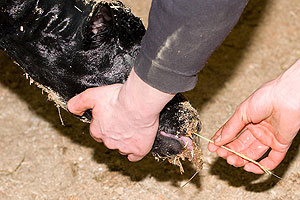Healthy Calf Conference
Follow to stay up-to-date on all Healthy Calf Conference updates. Speaker announcements, sponsorship information, registration announcements, and more.
While it is a relief to get a calf out after a hard calving, these calves are still highly vulnerable. Dystocia is a major risk factor for stillbirth and infectious disease in early life. Some calves born following severe dystocia can survive quite well, which can lead one to underestimate the further assistance that some other calves may require; calves that experience mild dystocia can still be affected quite negatively. For any calf you are present for immediately following birth, and particularly following a difficult calving, there are a few simple steps you can take to ensure that they not only survive, but that they thrive.

When a calf’s umbilicus is broken, it can no longer acquire oxygen from its dam, and must breathe in air. With difficult calvings, calves can develop respiratory acidosis. If this condition remains uncorrected, the calf can also develop metabolic acidosis. This causes the calf’s blood pH to rise, which can decrease the calf’s ability to absorb immunoglobulins (antibodies) from colostrum. Consider the following steps to help your calf overcome the challenge of a difficult start, and get them going right.
While it may be difficult to know which calves need extra help, these are simple and quick steps, some of which you may already use. These steps are useful for any calf, and will not cause harm even if the calf is not suffering negative effects from calving. Taking its temperature is also another reliable indicator of health; remember the newborn is a few degrees higher to start, but an excessive drop can indicate it is struggling.
However, one thing you should NOT do is the hang the calf upside down. This can often cause fluids to come out of the stomach, rather than the lungs. Instead, you can lay a calf over a bale, and just allow the head to extend over the edge, as recommended by Sheila McGuirk of the University of Wisconsin.
Continue to keep an eye on these calves as they grow. Consider tagging hutches or pens of calves from difficult calvings. You may want to handle these calves with extra care when moving them, as they can commonly suffer from fractured ribs.
Taking just a couple of extra minutes to get your calves breathing and dry, and ensuring quick colostrum are critical – for proper respiratory function, thermoregulation, and being able to fight disease!
Follow to stay up-to-date on all Healthy Calf Conference updates. Speaker announcements, sponsorship information, registration announcements, and more.
The Codes of Practice are nationally developed guidelines for the care and handling of farm animals. They serve as our national understanding of animal care requirements and recommended practices.